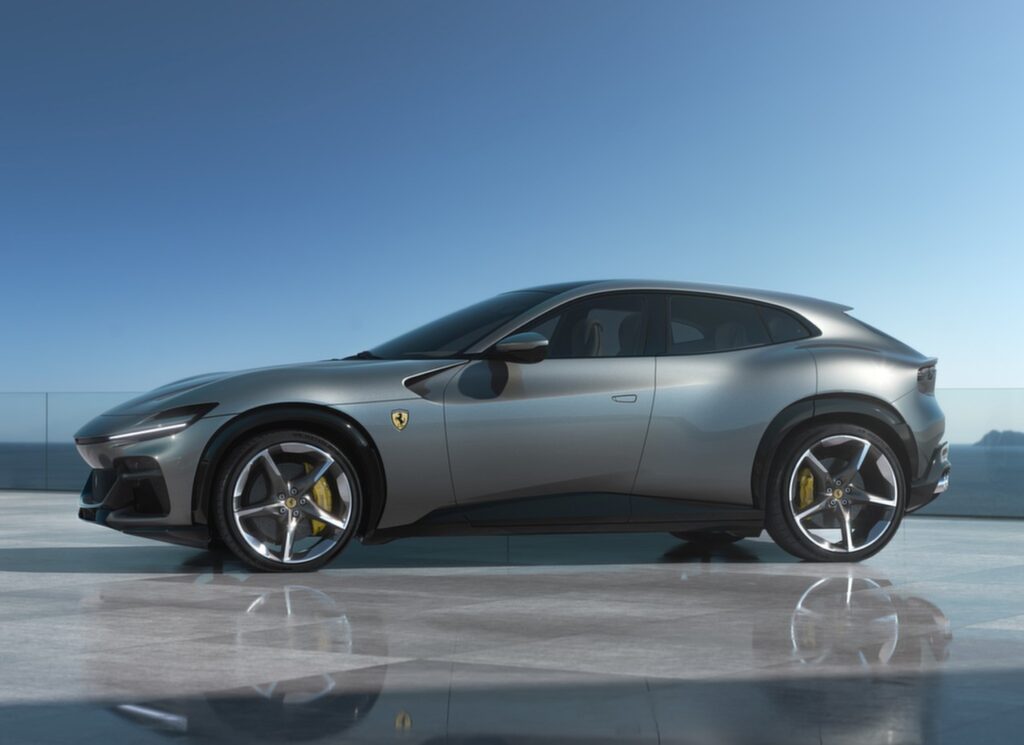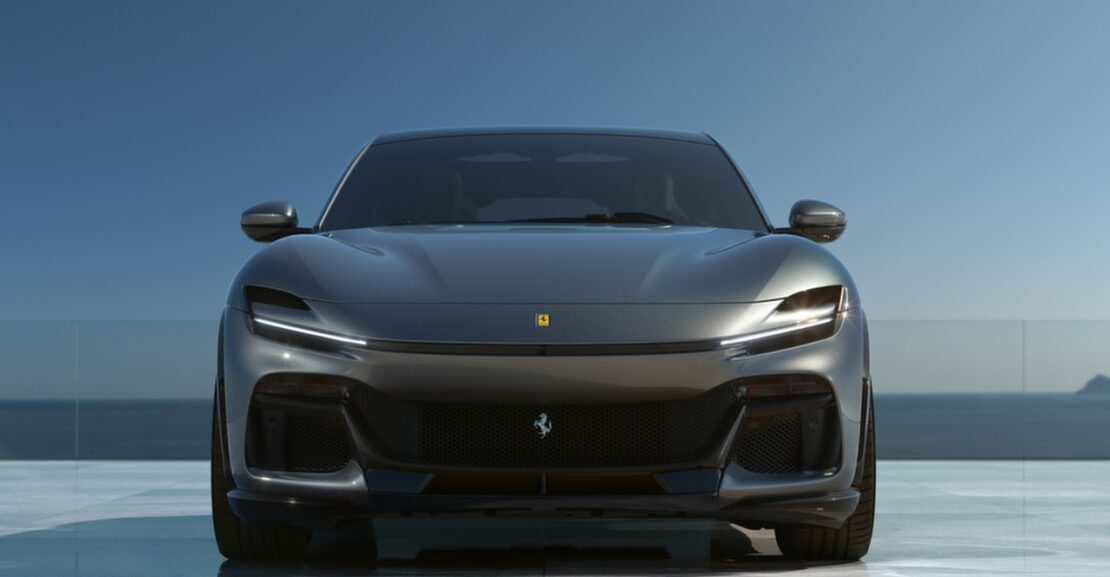Autofocus: 2023 Ferrari Purosangue
After an extended period of anticipation within the global automotive community, Ferrari has officially introduced the 2023 Ferrari Purosangue. This groundbreaking vehicle marks a historic departure for the renowned Prancing Horse brand as it represents their inaugural venture into the realm of four-door, four-seater cars in the course of its illustrious 75-year history. The grand unveiling took place amidst the captivating ambiance of the Teatro del Silenzio in Lajatico (Pisa).
Throughout its history, Ferrari has strategically integrated 2+2 cars, featuring two front and two smaller back seats, as integral components of its lineup. These vehicles have consistently blended benchmark performance with top-tier comfort, forming a pivotal foundation for the brand’s success. Now, after 75 years of pioneering research, Ferrari has birthed a vehicle that stands unparalleled on the global stage. The Purosangue not only harmoniously combines performance, driving pleasure, and comfort but also serves as a distinctive embodiment of the iconic DNA associated with the Prancing Horse. This is epitomized by the chosen name “Purosangue,” Italian for ‘thoroughbred.’
To realize the ambitious objectives set for this project and to craft a vehicle deserving of a place in Ferrari’s esteemed range, the Purosangue embraces a revolutionary layout and innovative proportions distinct from modern GT archetypes, such as crossovers and SUVs. While typical modern GTs position the engine forward in the car, nearly straddling the front axle with a directly coupled gearbox, the Purosangue adopts a mid-front-mounted engine with a rear-mounted gearbox, creating a sporty transaxle layout. The Power Transfer Unit (PTU) is situated in front of the engine, delivering a unique 4×4 transmission and achieving the optimal 49:51% weight distribution deemed ideal by Maranello’s engineers for a mid-front-engined sports car.
Setting itself apart in the market, the Purosangue boasts unrivaled performance and comfort. It stands as the only vehicle with these proportions to feature a mid-front-mounted, naturally aspirated V12 engine. This iconic engine configuration, with a power output of 725 cv, guarantees superior performance and delivers an enthralling Ferrari engine soundtrack. Additionally, the engine can provide 80% torque even at low revs, ensuring a unique driving experience at all times.
A meticulous focus on aerodynamic development has resulted in the Purosangue’s bodywork, underbody, and rear diffuser being optimized for efficiency. Innovative solutions, such as the synergy between the front bumper and wheelarch trim, generate an air curtain that aerodynamically seals the front wheels, preventing turbulent transverse air flows.
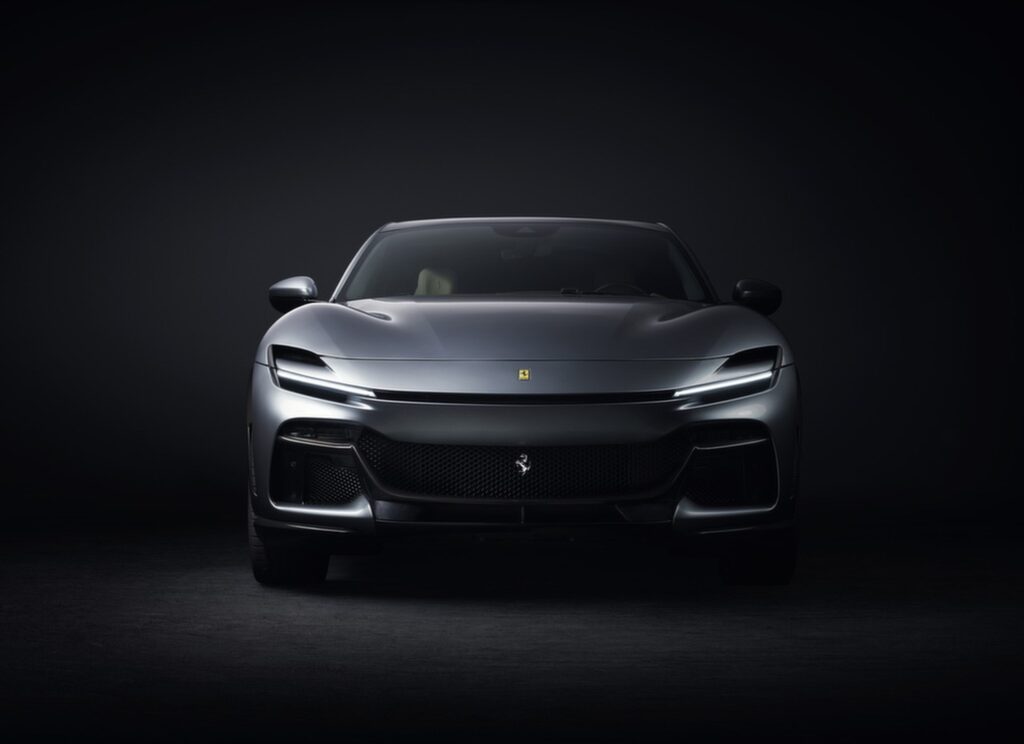
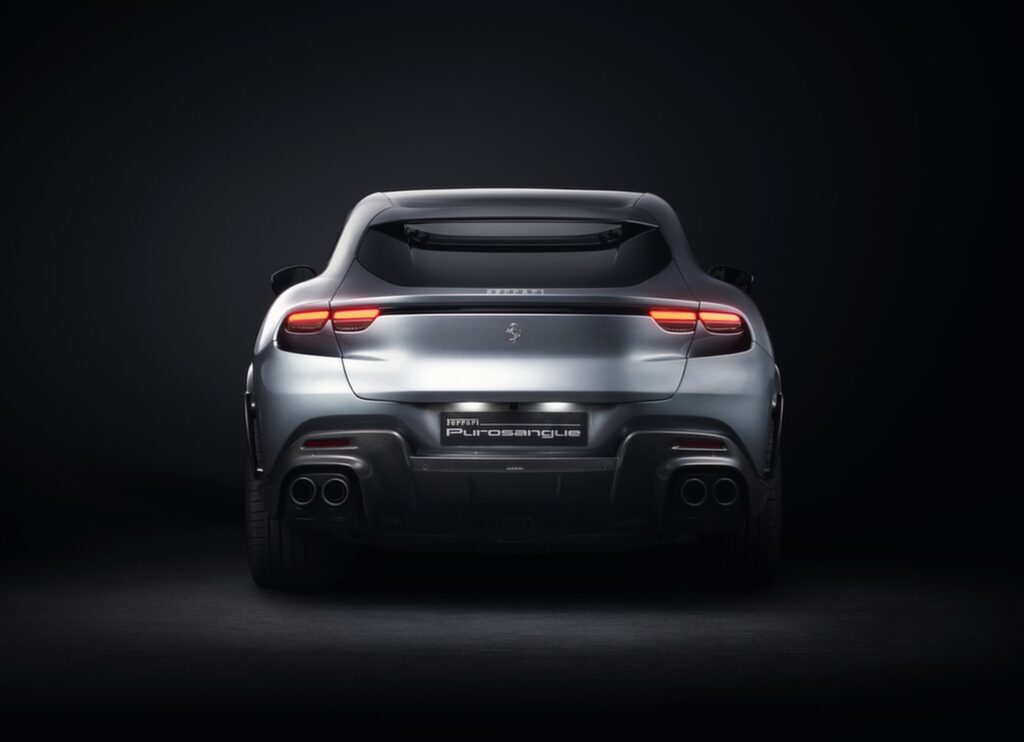
Ferrari has incorporated the latest iterations of vehicle dynamic control systems into the Purosangue, including independent four-wheel steering, ABS ‘evo’ with the 6-way Chassis Dynamic Sensor (6w-CDS), and the debut of the new Ferrari active suspension system. This system effectively controls body roll and tire contact patch, delivering performance and handling response akin to the marque’s sports cars.
The Purosangue features an all-new chassis with a standard carbon-fiber roof to reduce weight and lower the center of gravity. Redesigning the bodyshell from the ground up allowed for the inclusion of rear-hinged back doors (welcome doors) to enhance ingress and egress while maintaining a compact profile. The cabin accommodates four adults comfortably with generous heated electric seats, and the rear seats fold to expand the luggage space. The Purosangue’s driving position, while more commanding than other Ferraris, retains an intimate connection to the car’s dynamic capabilities.
This groundbreaking vehicle delivers class-leading performance figures (0 to 100 km/h in 3.3 s and 0 to 200 km/h in 10.6 s), offering a driving experience that is entirely new yet distinctly Ferrari. Standard features include a host of comfort-focused content, such as the Burmester© audio system, with additional optional extras, including the innovative Alcantara® upholstery derived from certified recycled polyester. These features collectively position the Purosangue as the most comprehensive four-door, four-seater in its segment.
POWERTRAIN
The heart of the Purosangue, known by its code name F140IA, upholds the architectural principles that have propelled Ferrari’s recent 12-cylinder engines to unparalleled success. Featuring a 65° angle between its cylinder banks, a substantial 6.5-liter capacity, a dry sump, and high-pressure direct injection, this powerplant is engineered to deliver a distinctive blend of torque at low revs while preserving the characteristic linear and enduring power synonymous with Ferrari’s naturally aspirated V12s. Remarkably, 80% of the maximum torque is available at just 2100 rpm, peaking at 716 Nm at 6250 rpm. The engine achieves a maximum power of 725 cv at 7750 rpm, exhibiting the responsive characteristics expected of a true sports car.
Significant redesigns in the intake, timing, and exhaust systems, coupled with cylinder heads derived from the 812 Competizione, mark the evolution of this powerhouse. Meticulous attention was devoted to enhancing mechanical and combustion efficiency, drawing inspiration from Formula 1-caliber calibration concepts. As a result, the Purosangue boasts the most potent engine ever developed by Ferrari for a four-seater car, reigning supreme in its segment and delivering the unmistakable Ferrari V12 soundtrack.
To maximize mechanical efficiency, the rotating masses underwent a redesign. The nitrided steel crankshaft was modified to extend the stroke, and internal oil passageways were revamped to optimize oil flow to the big-end bearings. Precision improvements in bearing clearance enhance consumption. Redesigned coolant and oil pump assembly, focusing on the scavenge section, minimizes friction and mass through smaller diameter rotors and optimized inlets and outlets.
A comprehensive overhaul of the valve train timing and a refined finishing process for the camshafts contribute to reduced surface roughness and friction coefficient. The intake ducts, plenums, and exhaust system underwent revisions to optimize torque curve and increase permeability while reducing back pressure. The engine incorporates specific pistons with a redesigned crown to boost combustion efficiency.
The direct injection system comprises two high-pressure fuel pumps (350 bar) delivering petrol to injectors in the combustion chambers. The ignition system, monitored by the ECU with an ion-sensing system, ensures precise control of ignition timing. The ECU, equipped with a single- and multi-spark function, optimizes combustion efficiency across all rev ranges. A patented function, derived from Ferrari’s Formula expertise, optimizes torque during transient acceleration maneuvers.
The F140IA’s sonic profile exemplifies the harmonious marriage of the engine’s combustion sequence and Ferrari’s expertise in cabin acoustics. Equal-length exhaust manifolds are tuned for perfect 12-cylinder harmony. The plenum with optimized intake duct complements the V12’s high notes with medium frequencies. Progressive silencers, now included in the Manettino settings, cater to both in-town and performance driving. The resulting soundtrack embodies the distinctive Ferrari V12 harmonics, subtly present until hard acceleration triggers an enthralling crescendo as the engine approaches the 8250-rpm red-line.
The 8-speed, oil-bath dual-clutch transmission underwent optimization with the adoption of a dry sump and a more compact clutch assembly, lowering the installed height by 15 mm and correspondingly reducing the center of gravity. The new clutch’s performance is significantly higher, transmitting up to 1200 Nm in dynamic torque during gear shifts. Faster clutch fill times contribute to reduced overall gear shift times compared to the previous 7-speed DCT. New gear ratios provide shorter and progressively spaced shifts, with a longer top ratio geared for improved fuel economy during highway driving. Calibrated downshifts prioritize smooth shifting, emphasizing driving pleasure and accentuating the sound of the new V12 engine.
CHASSIS AND BODY
The Purosangue’s chassis represents a paradigm shift, meticulously crafted from the ground up to achieve unparalleled rigidity without compromise. The lower chassis structure, constructed entirely from high-strength aluminum alloy, leverages Ferrari’s extensive expertise in optimizing the use of lightweight alloys. Collaborating with the structural elements of the upper body, it forms a spaceframe chassis composed of closed-section extrusions connected by castings that integrate load-bearing aluminum sheet metal elements.
Despite its larger size, the chassis is lighter than its predecessors among Ferrari’s four-seaters. Enhanced torsional rigidity (increased by 30%) and beam stiffness (improved by 25%) play pivotal roles in refining NVH (noise, vibration, and harshness) characteristics. This, in turn, translates into improved comfort by seamlessly and quietly absorbing irregularities in road surfaces while providing an extraordinary sense of structural integrity.
The innovative use of hollow castings with thin walls, produced using internal cores, contributes to optimizing the structure. This not only maximizes performance but also ensures improved continuity in stress lines, crucial for occupant safety. Additionally, this technology enhances assembly quality through more precise integration, reduced components, and fewer weld lines.
The bodyshell incorporates a mix of materials, ranging from aluminum to carbon fiber, with high-strength steel strategically introduced in critical areas. The combination of these materials achieves maximum strength where necessary while keeping weight to a minimum in non-stressed areas.
High-strength steel is employed for anti-intrusion bars, reinforcements on main nodes, and the B-pillar. Meticulous attention to detail in design resulted in the use of different materials within individual components. For instance, the single rear door hinge features an aluminum casting for the fixed part and a hot-stamped steel construction for the mobile part.
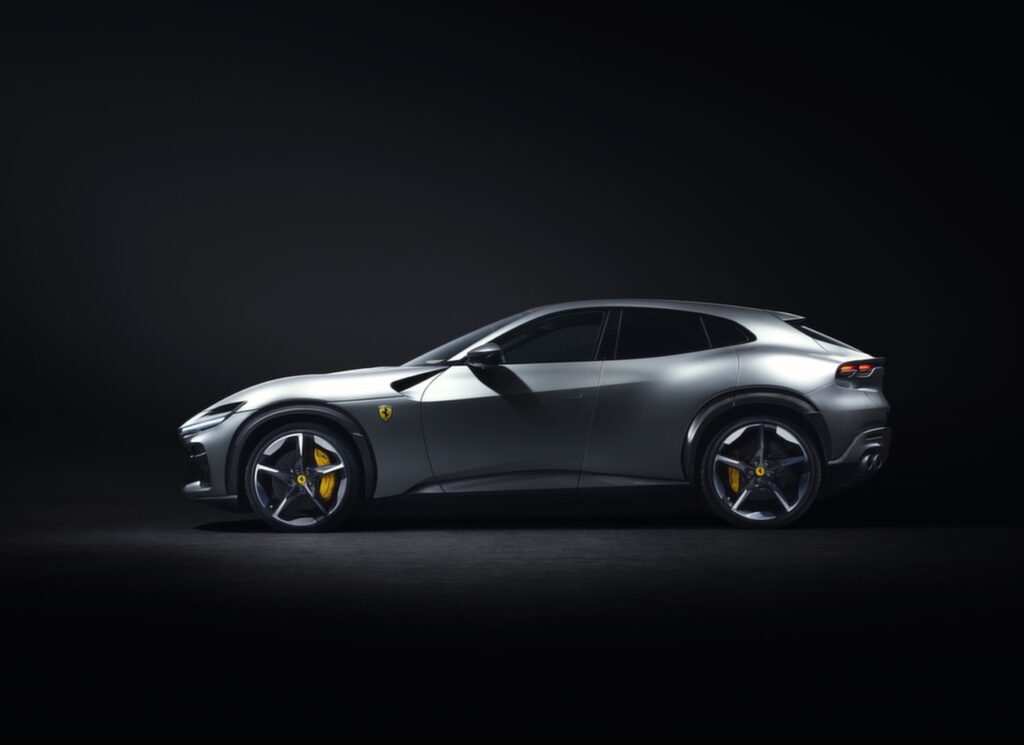
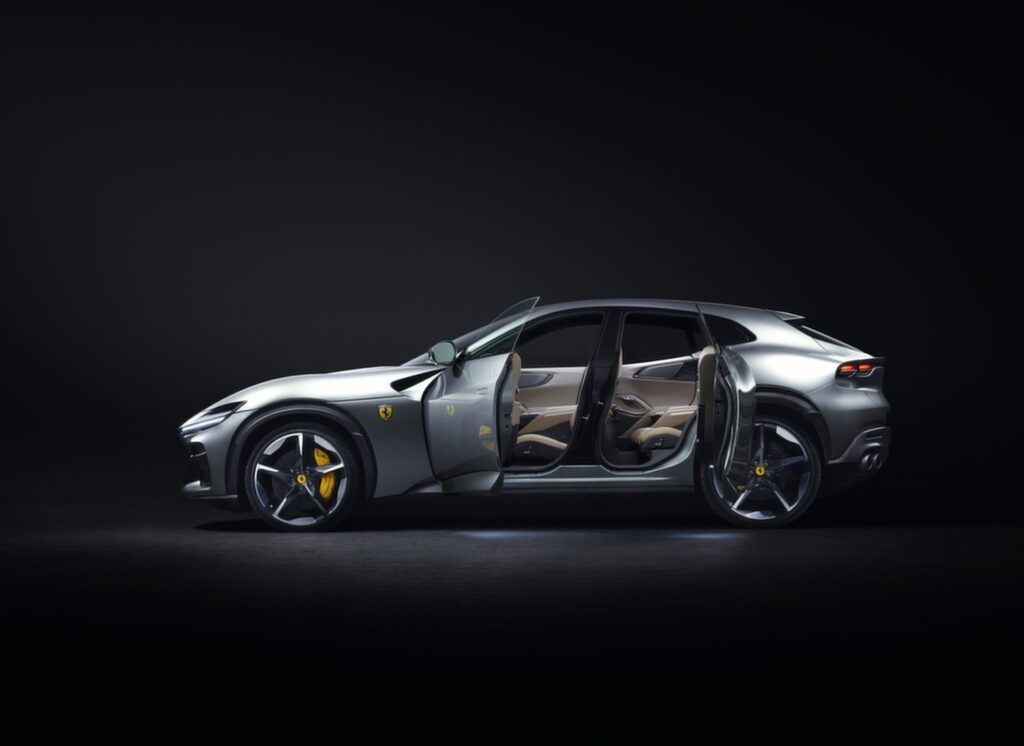
The single-shell carbon-fiber roof, integrated with soundproofing, is an entirely new addition, providing rigidity levels comparable to a glass roof while weighing 20% less than an aluminum roof with soundproofing. Prioritizing ergonomic considerations, the design emphasizes generous ingress space while maintaining a compact wheelbase. This is achieved through traditional front door openings with a 63-degree angle (five degrees wider than other Ferrari models) and a revolutionary electric, rear-hinged back door with a 79-degree opening. Inspired by iconic Ferrari designs, such as the bonnet opening on the Ferrari Monza SP1/SP2, the front-hinged bonnet allows for the creation of distinctive forms in the A-pillar area. The gooseneck hinge assembly for the bonnet is crafted from aluminum to ensure solidity and stability during opening.
The electrically activated aluminum rear hatch, equipped with two Stabilus tailgate lifters, opens to 73 degrees, facilitating easy access to the boot and simplifying the loading and unloading of even the largest luggage. The gooseneck hinge assemblies play a role in shaping unconventional aesthetic forms in the upper spoiler area, adding a distinctive touch to the Purosangue’s design.
AERODYNAMICS
The Purosangue presented a distinctive challenge for Ferrari’s aerodynamic department due to its unique volumes and constraints, necessitating a radical rethink of methods and solutions. The ambitious goal of drag reduction, coupled with specific demands for usability, accessibility, and effective cooling for the powerful V12 engine, required extensive wind tunnel testing and thousands of Computational Fluid Dynamics (CFD) simulations typically reserved for the fastest and most powerful sports cars in Ferrari’s lineup.
The central focus of the Purosangue’s aerodynamic design was the car’s centerline section, crucial for both airflow design and minimizing drag coefficient (Cd), as well as reducing frontal surface area. The front silhouette aimed at creating seamless continuity between the bonnet’s maximum curvature and the windscreen header rail. The rear area, including the roof, rear screen, and spoiler, underwent meticulous work to manage flow separations and pressure fields effectively.
Achieving a balance between a smooth roof-rear screen line and reducing the tail’s height involved two key elements: the suspended spoiler and the nolder on the boot’s lip. The suspended spoiler neutralizes the roof’s curvature, while the low-profile nolder channels wake vortices for a slight recompression at the car’s tail.
Moving to the rear volume, a scoop starting at the rear roof extends onto the rear screen, creating crests on each side to maintain headspace for rear-seat passengers while managing airflow separation.
Addressing the wake from the wheels, various solutions were implemented, including louvres in the floating wheelarch trim. The front wheelarch trim features a complex system, where the bumper and louvre work together to create an air curtain sealing the front wheels and preventing transverse turbulence. Additional ducts and vents are strategically placed to optimize air extraction.
The aerobridge, a suspended wing on the bonnet, aids in reducing drag. It energizes the air passing beneath it, minimizing the negative impact of the vortex at the base of the windscreen and accelerating the flow for efficient evacuation.
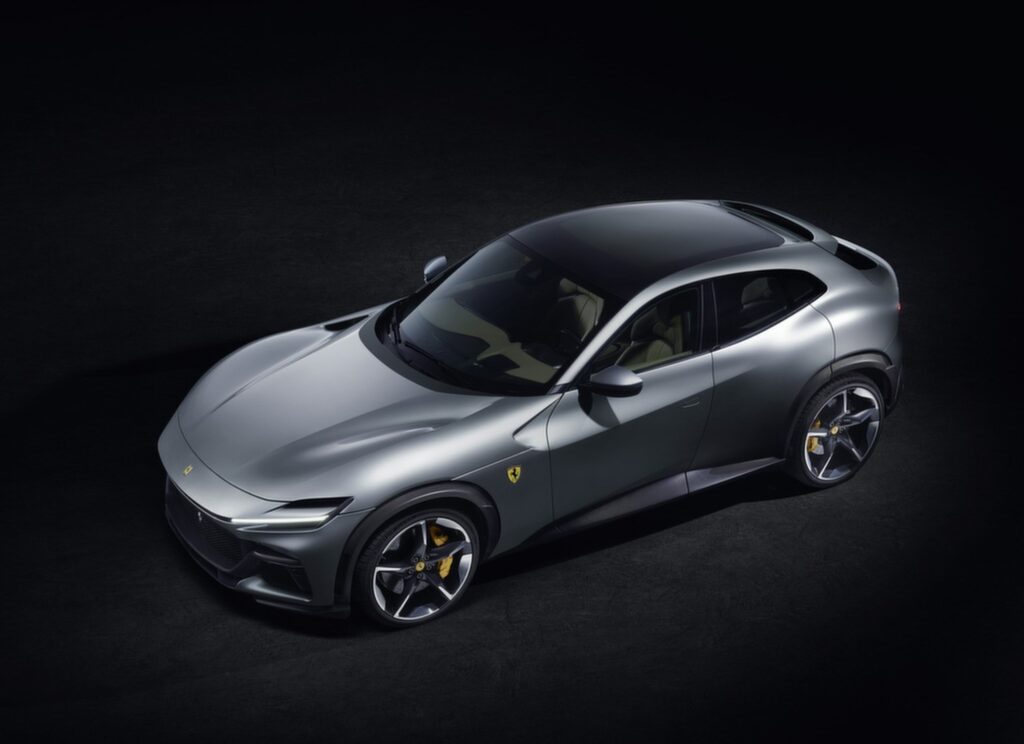

A blown channel from the front bumper to the underbody maximizes air channeled toward the underbody. This system, combined with negative ramps ahead of the front wheels, enhances downforce. Flaps and vortex generators behind the front wheels optimize the efficiency of radiating masses while reducing drag.
The rear diffuser design underwent careful optimization, focusing on synergy with the upper body and rear bumper. A subtle nolder at the end of the expansion of the air flow boosts efficiency and maximizes hot air extraction from the gearbox and exhaust system compartments.
With no rear windscreen wiper, the rear screen is cleaned by the air flow along the glass surfaces. The curved lower surface of the suspended spoiler directs air toward the rear screen, aided by vortex generators to ensure uniform scrubbing.
Unconventional headlight placement allows for two air intakes above and below the daytime running lights (DRL). The upper one channels air into the complex blown system under the front aerobridge, while the lower one directs air to the brake cooling system. Intakes for radiating masses are strategically positioned for cooling purposes, including those for the active dampers, the Power Transfer Unit (PTU) circuit, and the naturally aspirated V12’s oil and coolant radiators at the central intake. The design includes air-catchers to maximize the quantity of air channeled through these intakes.
VEHICLE DYNAMICS
The development of the Purosangue’s dynamic performance aimed at creating an unprecedented car on the global stage, offering top-tier usability and comfort while maintaining the signature Ferrari vehicle dynamics and performance. One of the standout features is the world-first Ferrari active suspension technology, powered by Multimatic’s True Active Spool Valve (TASV) System. This innovative suspension architecture combines electric motor actuation with a high-precision spool valve hydraulic damper, providing active control with more force authority and higher frequencies than traditional adaptive systems.
Ferrari’s active suspension system incorporates a 48-volt motor actuator (TASV) that quickly applies force in the direction of the damper’s stroke. The motor, co-developed by Ferrari, utilizes “slotless” stator winding technology for enhanced power density. The unique transmission of motor force via a twin-lead ball screw directly to the hydraulic damper piston rod allows for high-frequency response, reducing friction, inertia, and package space.
Accelerometers and position sensors on each suspension corner, in conjunction with the Side Slip Control (SSC) 8.0 and 6w-CDS sensor, facilitate the active suspension system’s control. Ferrari’s proprietary logic, combined with TASV dampers from Multimatic, manages every aspect of the fully active suspension system. This technology optimizes cornering performance by dynamically adjusting roll stiffness, lowering the roll center, and actively controlling body motion and wheel movement.
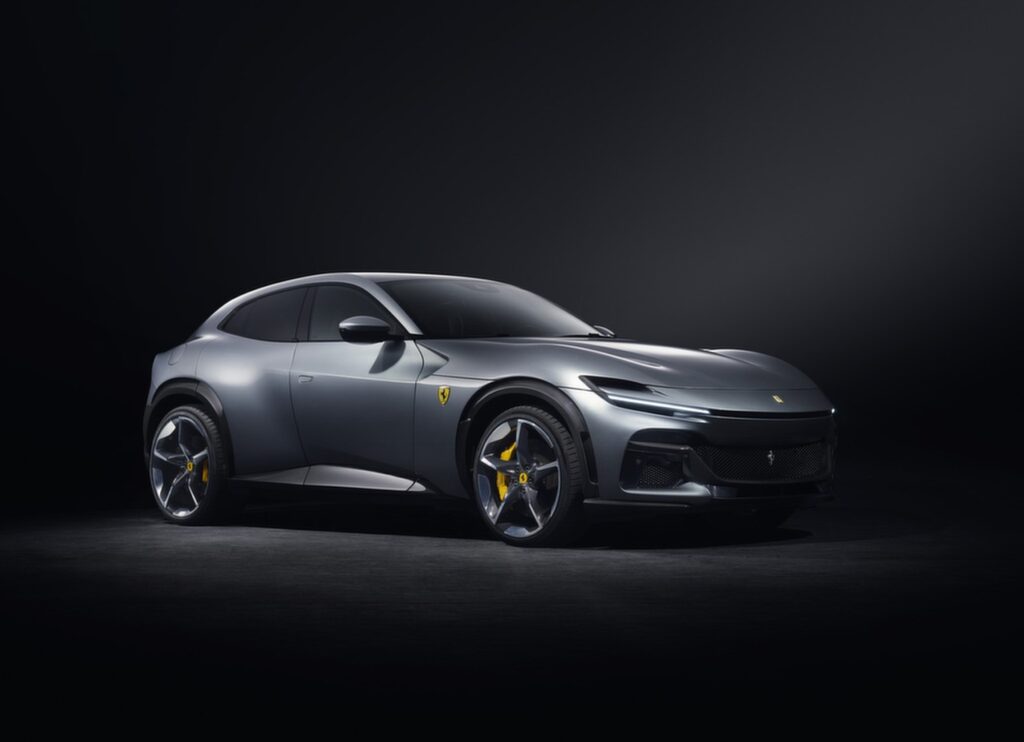
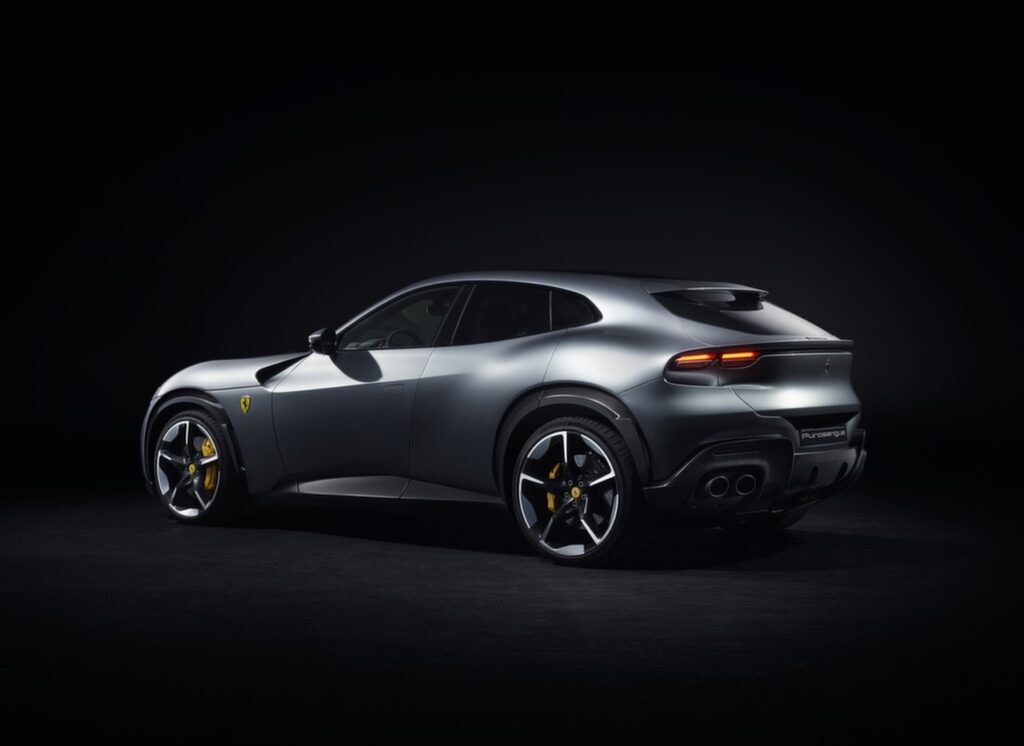
In addition to the active suspension, the Purosangue features a new front semi-virtual high wishbone suspension with reduced scrub radius for improved steering response. The car is equipped with the ABS ‘evo’ controller co-designed with Bosch and integrated with the brake-by-wire system. This controller optimizes performance in all road conditions and Manettino settings, enhancing accuracy in estimating slip targets for the four wheels under braking.
The Purosangue benefits from a developed 4RM-S system, incorporating innovations from the SF90 Stradale’s 4WD system and the new independent 4WS seen on the 812 Competizione. Yaw management during acceleration is optimized through Torque Vectoring, E-Diff torque distribution, and 4WS lateral force generation. The SSC 8.0 integrates all control systems, creating a synergy with the new ABS evo.
Driving thrills are emphasized through new objective longitudinal indicators, showcasing the Purosangue’s performance targets. The 8-speed DCT transmission, shared with the SF90 Stradale and 296 GTB, offers shorter ratios for more progressive acceleration. The transmission’s software control enhances performance, reduces shift times, and introduces a “Sailing” function for decoupling the engine and gearbox under specific driving conditions.
Advanced Driver Assistance features (ADAS) developed with Bosch include Adaptive Cruise Control, Automatic Emergency Brake System, Auto High Beam, Lane Departure Warning, Lane Keeping Assist, Blind Spot Detection, Rear Cross Traffic Alert, Traffic Sign Recognition, Driver Drowsiness and Attention, and rear-view parking camera. Hill Descent Control (HDC) is introduced on a Ferrari, aiding in maintaining controlled speeds on steep descents.
STYLING
The introduction of the Purosangue marks the creation of a pioneering market segment, breaking new ground for the Prancing Horse. With its innovative and contemporary architecture, the Purosangue seamlessly blends unprecedented comfort with Ferrari’s renowned performance and driving exhilaration. The Ferrari Styling Centre, under the leadership of Flavio Manzoni, took on the thrilling challenge of translating the distinctive DNA of the Prancing Horse into a vehicle that not only pushes the boundaries for Maranello but also redefines standards in the global automotive realm.
The name Purosangue aptly captures the essence of the car’s architecture. Its sleek and athletic exterior distinguishes it from other four-door, four-seater vehicles in the market. The mid-front-mounted naturally-aspirated V12 engine, combined with a luxuriously spacious and meticulously designed cabin, reinforces the car’s unique identity. The Purosangue is not merely a high-performance and agile vehicle; it also offers an abundance of space on board, ensuring exceptional comfort for all four occupants.
EXTERIOR
The Purosangue’s exterior design is a masterful composition, skillfully sculpted to create its distinctive and unique shape. The design incorporates two clearly defined levels: the lower, more technical underbody, and the gracefully sinuous and commanding upper body. This visual separation is accentuated by the upper volume appearing to float above the wheel arches.
Despite the imposing volumes of the Purosangue, the stylistic treatment of its height creates an overall impression of lightness. To give the car a robust and powerful stance, the Ferrari Styling Centre opted for boldly original forms. The design, conceived as a sculpture showcasing its remarkable aerodynamic development, is evident in various details such as the pontoon effect of the aerobridge between the front and flanks.
Every aero element is seen as an opportunity to enhance the sculptural look, emphasizing the car’s stylistic message. The theme of lightness and compactness extends to the roof, with its characteristics highlighted by the imposing rear wings that contribute to the car’s unique proportions.
The front of the Purosangue seamlessly flows into the flanks, employing a dynamic, horizontal language. Unlike traditional front grilles, the Purosangue features a dihedral suspended on the lower section, creating a more technical aesthetic. The absence of a front grille is replaced by a suspended disc form with integrated cameras and parking sensors. The front styling is dominated by blown aero ducts rather than conventional headlights.
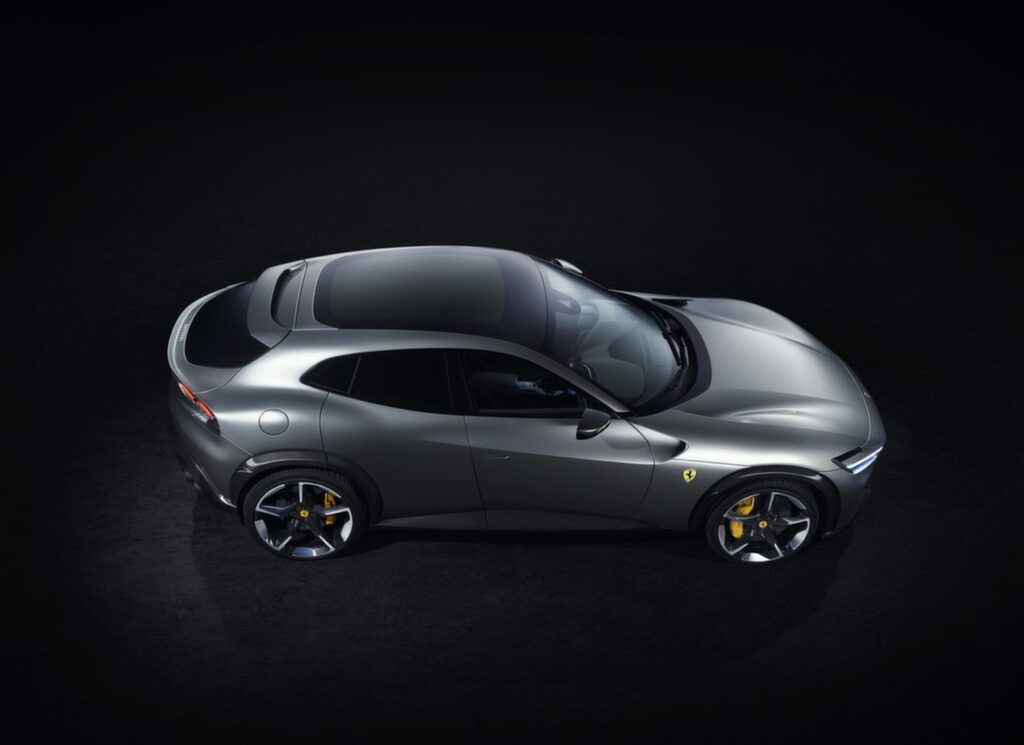
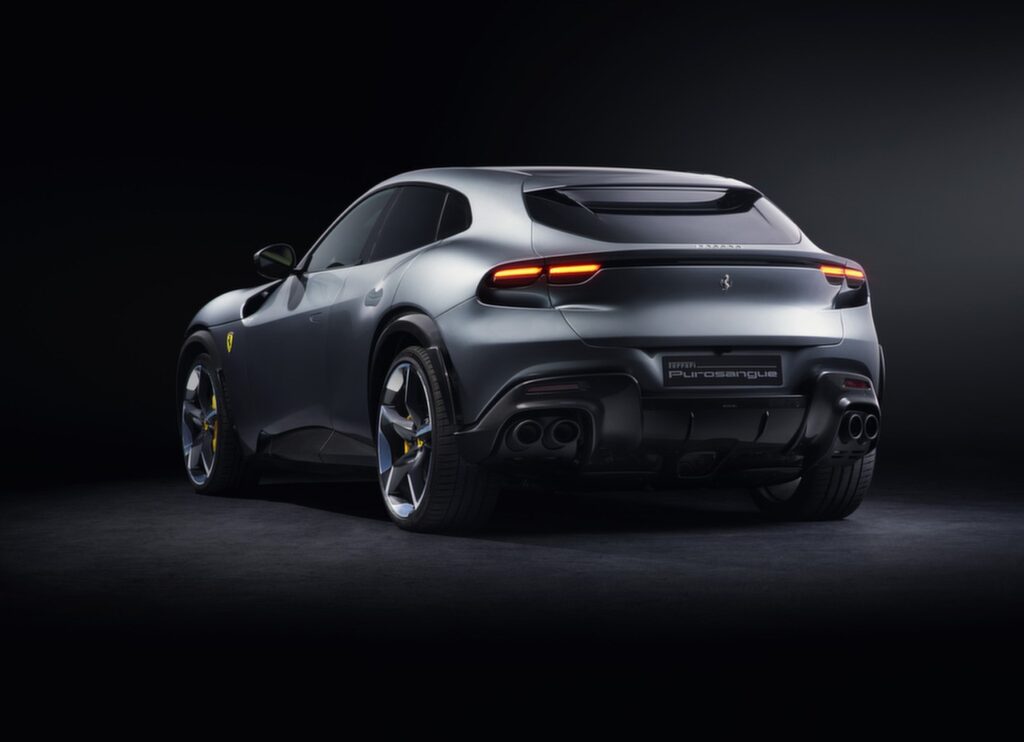
The upper section of the disc is supported by an element cooling the engine radiator, and aerobridges create continuity between the bonnet and flanks. The aerobridge theme characterizes the flanks, creating a dihedral shape that ends in the impressive rear muscles. The wheel arch trim reveals the Purosangue’s second skin beneath the bodywork, creating the impression of a floating coupé.
The rear design incorporates horizontal cut lines, integrating taillights and converging scoops into vents. The imposing diffuser and large rear wings contribute to a wide and sporty tail. The compact dimensions maintain a sporty bearing without compromising occupant space. The cabin profile features a slanted windscreen, A-pillars flowing into the rear spoiler, and distinctive crests on the rear screen.
Specific forged wheels designed for the Purosangue reflect the aero concept from the SF90 Stradale, with radial elements aiding hot air extraction from the wheel arch. These aero appendages, highlighted with an elegant diamond-cut finish, emerge from three-dimensional surfaces, adding to the overall aerodynamic efficiency and visual appeal.
CABIN
The Purosangue’s cabin reflects meticulous design in both space and furnishings, providing unprecedented occupant space and comfort for a Ferrari four-seater. The interior resembles an elegant and sporty lounge, exhibiting a sophisticated luxury that balances both elegance and modernity. The driver’s cockpit, inspired by the SF90 Stradale, is mirrored on the passenger side, creating emotional engagement for both front occupants.
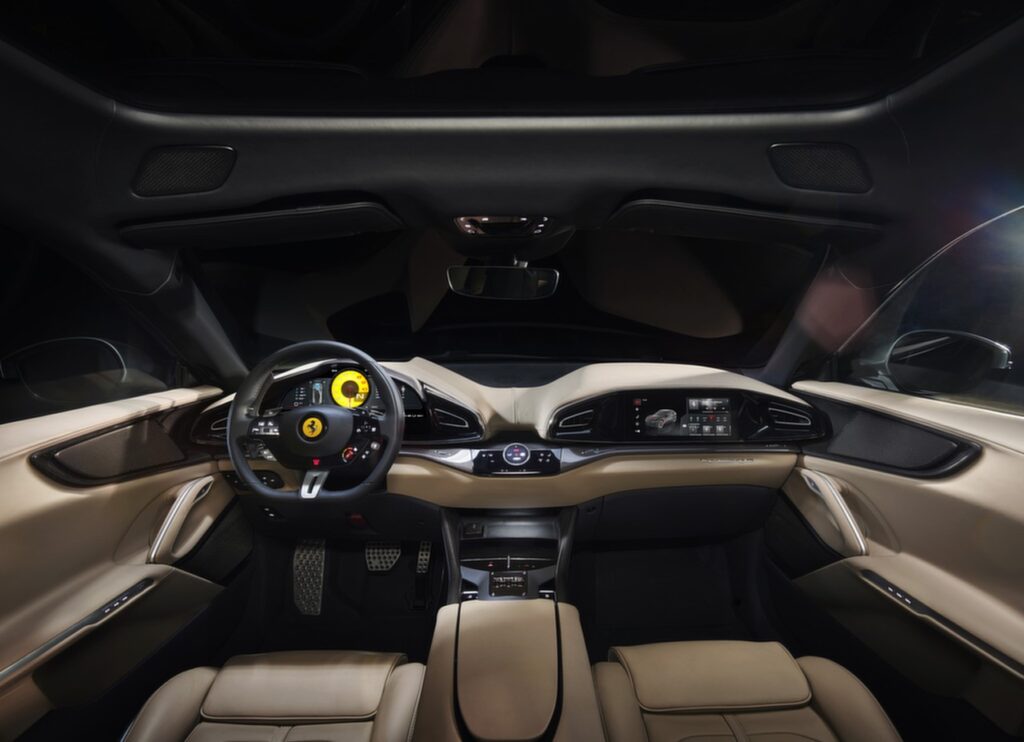
The interior architecture is based on the dual cockpit dashboard concept, extending and replicating it in the back, resulting in four distinct areas in terms of functionality, volumes, materials, and colors. The cabin composition develops horizontally, creating a sense of spaciousness and dynamic volumes. The wraparound forms converge towards the center, emphasizing the dual cockpit concept at the front and rear.
Controls for comfort-related features are located on a hideaway rotary interface in the central dash, and rear passengers have access to similar functions via a second rotary interface. The tunnel, with a luxury trim, combines with a Y-shaped structural element dominated by the metal gear-shift gate. The cabin integrates comfort-focused components, armrests, and door handles, with four separate and independently adjustable seats, a first in Ferrari history.
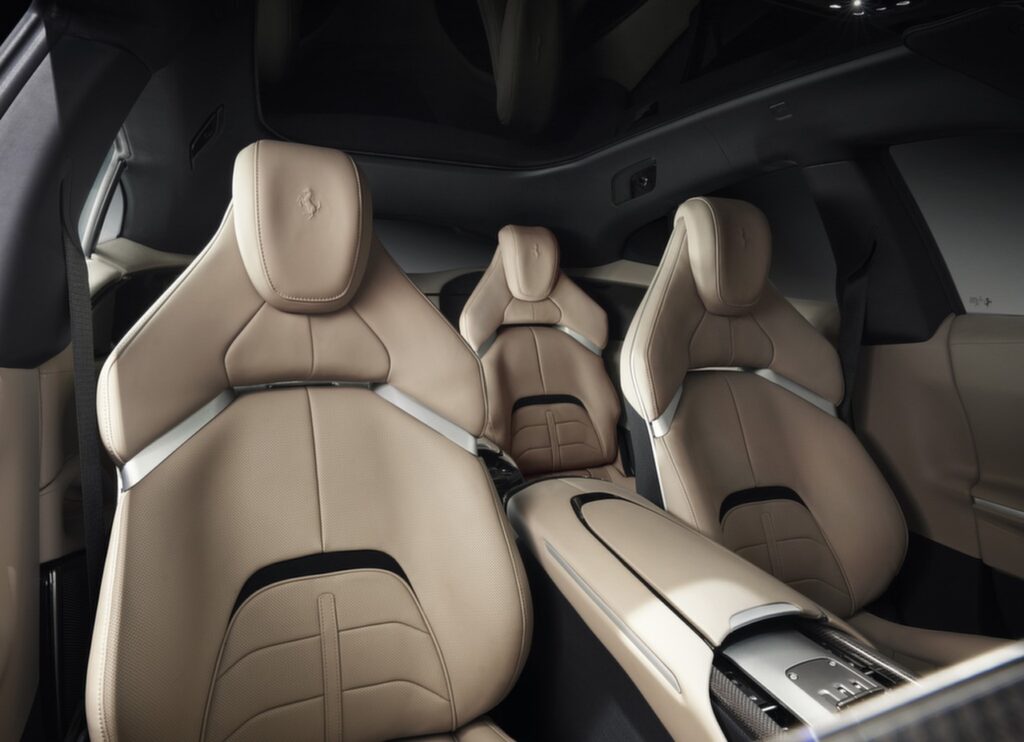
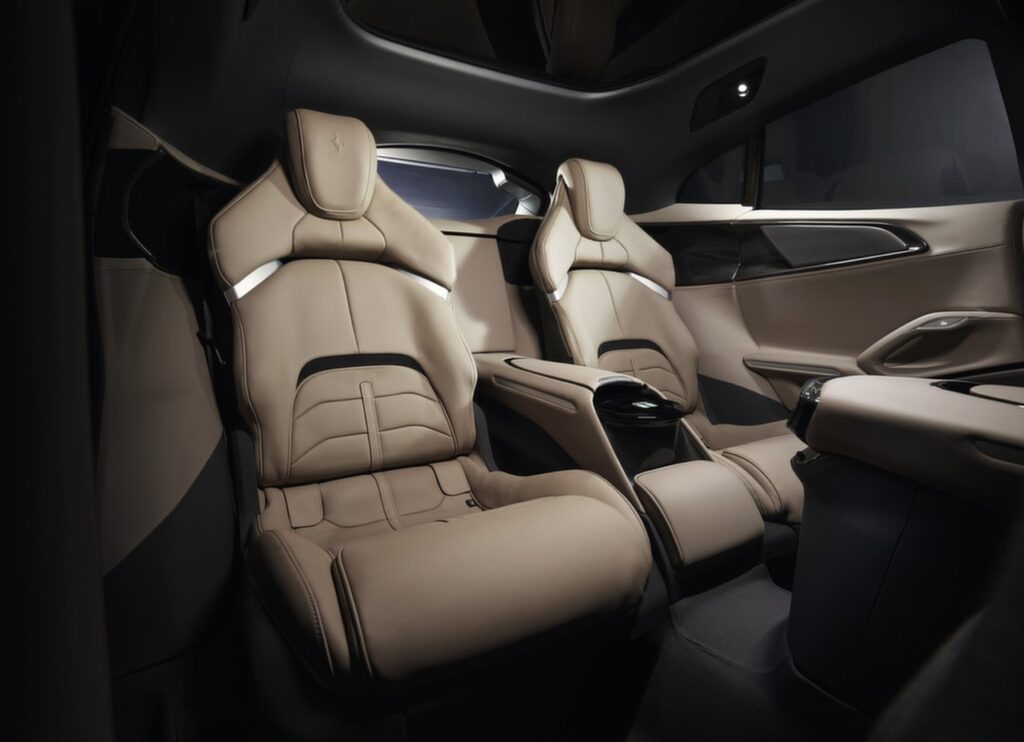
The Purosangue prioritizes sustainability, incorporating extensively sustainable materials. For instance, 85% of the launch trim uses sustainably produced materials, such as recycled polyester for the fabric roof-lining and carpets made from recycled polyamide. Alcantara® used in the Purosangue is made of 68% post-consumer recycled polyester, a world-first in automotive use, certified by the Recycled Claim Standard.
Owners can opt for high-strength fabric used in military uniforms for the floor trim instead of traditional carpeting or leather. The Purosangue introduces a dark brown semi-aniline leather and an optional carbon-fiber weave with fine copper wire for a sophisticated take on traditional carbon fiber.
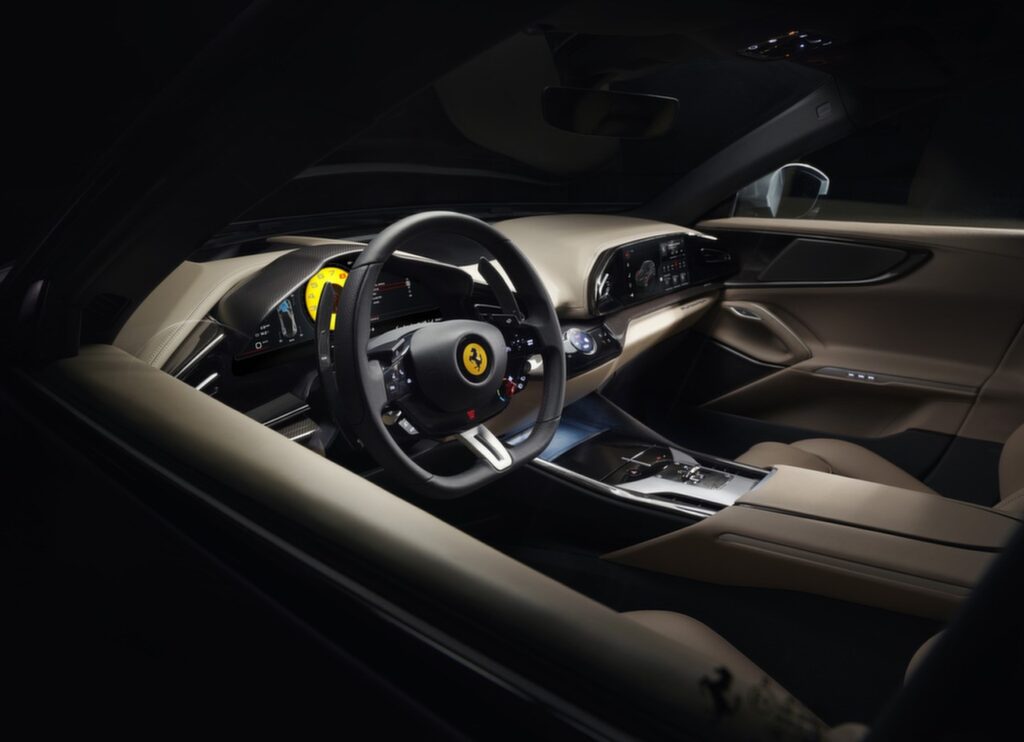

The Burmester® 3D High-End Surround Sound System debuts in a Ferrari as standard equipment, offering ultimate audio performance with innovative technologies, including a ribbon tweeter and a subwoofer in a closed cabinet for bass clarity and power. The launch color, Nero Purosangue, is specifically developed for the car, producing intense red reflections in certain lighting conditions to enhance its volume.
OPTIONAL EQUIPMENT AND PERSONALISATION
The Purosangue provides a wide range of optional content and personalization choices, allowing owners to find the perfect balance between comfort and performance. Beyond various exterior and interior colors, including some exclusive to the model, the Purosangue introduces innovative solutions new to the Ferrari range and the market.
For the first time in a Ferrari, owners can personalize the roof with a full-length electrochromic glass roof instead of the standard carbon-fiber version. The glass is coated with an electro-sensitive film on its lower surface, allowing owners to adjust its tint level, flooding the cabin with sunlight or providing shade as needed.
The massaging front seats feature 10 airbags that deliver a targeted massage with five different types and three levels of intensity, enhancing comfort during drives.
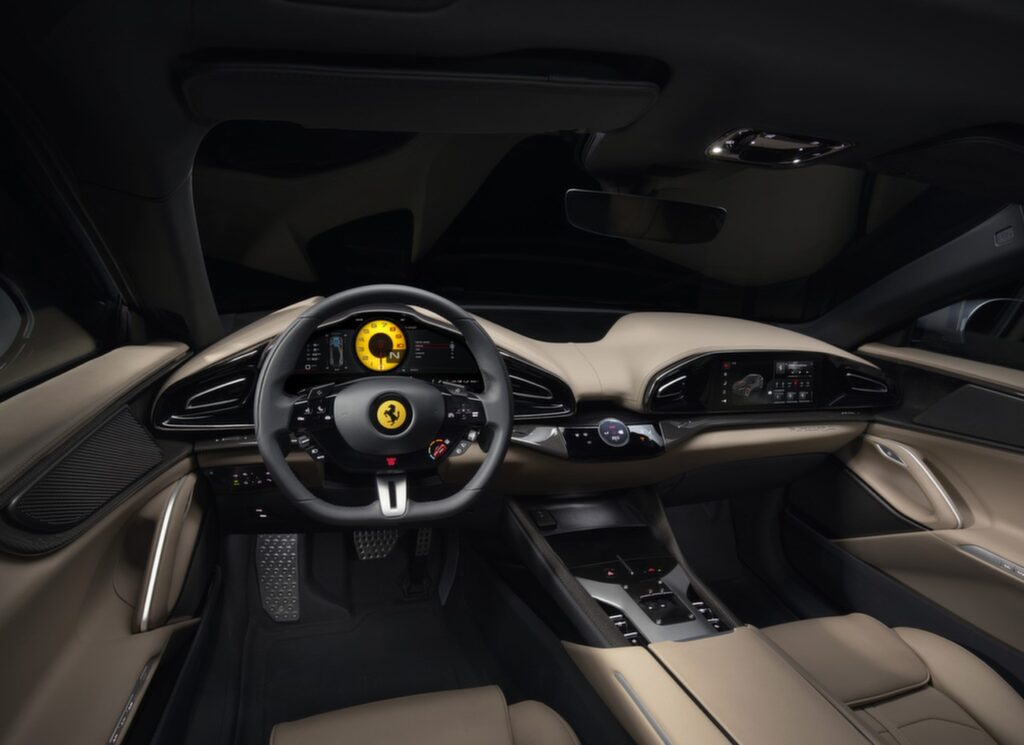
An air quality sensor, a first for the Ferrari range, checks the air outside the car and improves cabin air quality through smart air recirculation control and filters that can prevent particles of up to PM2.5 from entering the car.
Another first for Ferrari is the integration of Android Auto and Apple CarPlay systems as standard, substituting the traditional built-in navigation system. This provides seamless connectivity and enhances the overall infotainment experience for the driver and passengers.
7-YEAR MAINTENANCE
Ferrari ensures unparalleled quality standards and a heightened focus on client service, as evidenced by the extended seven-year maintenance program offered with the Purosangue. This program, available across the entire Ferrari range, covers all regular maintenance for the first seven years of the car’s life. It is an exclusive service that provides clients with the assurance that their car will be maintained at peak performance and safety over the years. This special service is also available to owners of pre-owned Ferraris.
The Genuine Maintenance Programme includes regular maintenance at intervals of either 20,000 km or once a year with no mileage restrictions. It covers original spares and meticulous checks conducted by staff trained directly at the Ferrari Training Centre in Maranello, utilizing the most modern diagnostic tools. This comprehensive after-sales service is available on a global scale and from all dealerships within the Official Dealership Network. The Genuine Maintenance program is part of Ferrari’s commitment to meeting the needs of clients who aim to preserve the performance and excellence that define all cars built in Maranello.
PUROSANGUE – TECHNICAL SPECIFICATIONS
POWERTRAIN
- Type: V12 – 65° – dry sump
- Overall displacement: 6496 cc
- Bore and stroke: 94 mm x 78 mm
- Max. power output*: 725 cv at 7750 rpm
- Max. torque: 716 Nm at 6250 rpm
- Max. revs: 8250 rpm
- Compression ratio: 13.6:1
- Specific power output: 111 cv/l
DIMENSIONS AND WEIGHT
- Length: 4973 mm
- Width: 2028 mm
- Height: 1589 mm
- Wheelbase: 3018 mm
- Front track: 1737 mm
- Rear track: 1720 mm
- Dry weight**: 2033 kg
- Dry/power ratio: 2.80 kg/cv
- Weight distribution: 49% front / 51% rear
- Fuel tank capacity: 100 litres
- Boot capacity: 473 litres
TYRES AND WHEELS
- Front: 255/35 R22 J9.0
- Rear: 315/30 R23 J11.0
BRAKES
- Front: 398 x 38 mm
- Rear: 380 x 34 mm
TRANSMISSION AND GEARBOX
- 8-speed F1 DCT
ELECTRONIC CONTROLS
- SSC 8.0: 4RM-S evo, Ferrari active suspension technology, F1-Trac, ABS ‘EVO’ with Grip Estimation 2.0, ECS
PERFORMANCE
- Max. speed: > 310 km/h
- 0-100 km/h: 3.3 s
- 0-200 km/h: 10.6 s
- 100-0 km/h: 32.8 m
- 200-0 km/h: 129 m
FUEL CONSUMPTION AND CO2 EMISSIONS
- Under homologation
